Best Betta Fish Plants
Have you ever imagined a betta tank full of bright green plants, where your fish swims around happily and rests in quiet little spots? It sounds amazing, doesn’t it? But sometimes, the plants just won’t grow. Or worse, they die and make the tank messy. That can be really frustrating.
If you envision something where plants grow within tank that looks beautiful with minimal effort, let us help you create such a lovely scene.
Bettas thrive in dense and plant-rich habitats. It’s important to recreate their natural environment in their aquariums by providing similar types of plants. However, for beginners, identifying and learning about suitable plants can be challenging since it requires a deep understanding of the betta’s natural habitats.
Over the years, we’ve experimented with various plants, achieving great success in their growth and learning exactly what they need to flourish under typical betta conditions. Based on our experience, we recommend some of the best live aquarium plants for your betta fish. By the end, you’ll have the knowledge and confidence to create a stunning, natural sanctuary that benefits both you and your beloved betta.
Benefits of Live Aquarium Plants
Adding live plants to your aquarium serves a purpose beyond just creating an attractive environment. They offer various benefits for your betta tank. These plants:
- Improve water quality by absorbing carbon dioxide and releasing oxygen into the aquarium.
- Act as a natural filter by reducing algae growth.
- Provide hiding places and create a sense of security to betta splendens. They also help reduce stress because bettas are territorial and can become stressed in barren environments.
- Encourage natural behaviors in bettas, such as exploring, hiding, and resting on broad leaves, which can improve their overall mental and physical health.
- Provide a habitat for useful bacteria that aid in the nitrogen cycle, breaking down waste products and maintaining a balanced ecosystem.
- Help in stabilizing water parameters by absorbing the toxic nutrients (using up nitrate and phosphates).
- Create a beautiful, vibrant and visually appealing aquarium.
Understanding Betta Tank Conditions for Plants
It’s very important to ensure that the plants you use in your betta tank have the same requirements as your betta fish. A mismatch in their needs can lead to an unhealthy and barren tank environment. Betta tank conditions greatly influence plant selection and care.
Let’s understand this with an example. If you have a 5-gallon betta tank and add a fast-growing, aggressive plant, would it be a good match? Not at all!
The same principle applies to conditions such as betta temperature, lighting, substrate type and water flow. In our list, you’ll find plants whose needs align perfectly with those of bettas and are also very easy to care for.
How to Grow and Maintain Live Plants?
No matter how many easy-to-care plants you add to your tank, it still requires a certain level of effort. Successful planting and maintenance demand the right steps and proper care. We have a separate guide on growing aquarium plants, but the infographic below will help you easily understand the process.
Common Problems Beginners Face with Aquarium Plants
It’s common, especially among newbies, for them to not achieve what they want or for things to go as planned while growing plants. They buy beautiful, lush plants and imagine a vibrant underwater jungle, then see leaves turning brown, algae taking over, or mysterious snails popping up overnight.
If you’re the one facing the same, don’t worry, you’re not alone! Most beginners run into these issues. Let’s break down the common plant problems, why they happen, and simple and beginner-friendly solutions that actually work.
| Problem | Likely Cause(s) | Solution(s) |
| Yellowing Leaves | Nutrient deficiency (iron), old leaves, poor light | Increase liquid fertilizer, check tank lighting duration/intensity, remove old leaves |
| Holes in Leaves | Nutrient deficiency (potassium), snail damage | Increase liquid fertilizer, remove pest snails |
| Melting Leaves | Poor water quality, lack of nutrients, temp. shock | Ensure stable temperature, check water parameters, add fertilizer |
| Algae Growth | Excess light intensity, excess nutrients | Reduce lighting duration (8-10 hrs.), increase water changes |
| Stunted Growth | Insufficient light, lack of nutrients | Check lighting, increase fertilization, verify temperature is suitable for the plant. |
| Brown/Transparent Leaves | Lack of nutrients, poor light penetration, cold water. | Increase fertilization, ensure plants aren’t overcrowded, check temperature. |
Top 10 Best Live Plants for Betta Fish
Over time, I’ve noticed that my bettas are always more active and relaxed when their tanks have live plants. They love weaving through the leaves, resting on broad ones, and using the plants as little hideouts. I’ve tested quite a few different plants in my own setups, and some turned out to be much easier to care for than others. However, keep in mind that these are not the final options of betta fish plants for your aquarium. And you don’t need all of them, just pick the ones that fit your setup best.
1. Amazon Sword (Echinodorus Amazonicus)
Amazon Sword is a tropical South American swamp plant that thrives above and below the water, making it an excellent choice for aquariums. It is an oxygen powerhouse, easy to care for, and offers attractive coverage. Bettas enjoy swimming around and resting on its broad leaves. Its dense foliage can help reduce aggression if you have more than one fish in your aquarium.
This sturdy plant can adapt to a wide range of water conditions. It can survive in low light, though it needs higher light levels to thrive, with a range of 40-250 PAR. The temperature range for Amazon Sword is 70-82°F, which corresponds with that of betta fish. The pH requirements for Amazon Sword range from 6.5 to 7.5. It does not require CO2 to thrive, making it popular in low-tech setups and natural or biotope aquariums.
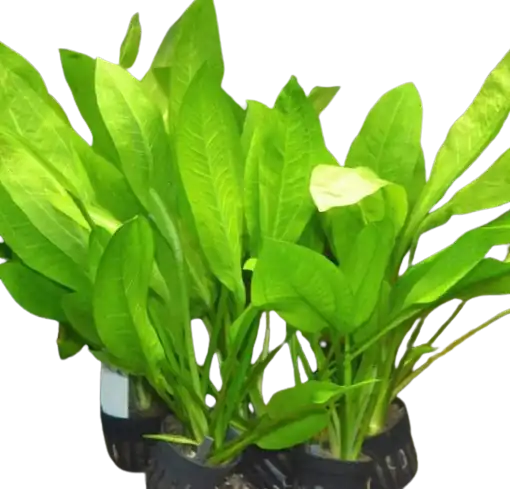
The Amazon Sword can be propagated in various ways, including division, runners and flower stems. However, the division method is most recommended. Once the plant has grown large enough with multiple crowns, gently remove it from the substrate and divide it at the roots with a sharp knife or scissors. Plant each new section into the substrate, ensuring the roots are well covered, and the crowns are above the substrate. Soon, it will grow into a new plant.
Amazon Swords are hardy plants with heavy roots that grow well in nutrient-rich substrates. Fluval Stratum or Seachem Flourite provides an iron-rich base that promotes root growth and overall plant health. A substrate thickness of 3-4 inches is recommended, allowing the Amazon Sword’s extensive root system to gather nutrients and anchor the plants in place.
Remember that this plant grows quite large, so make sure your tank suits it. It may not be the best choice for smaller tanks but it does very well in tall and medium-sized tanks.
The Amazon Sword can have a lifespan of 1.5-3 years but with proper care and optimal water conditions, it can live longer. I have one that has thrived for more than four years. To maintain the plant’s health, regularly trim any dead or yellowing leaves. This also helps prevent decay from affecting water quality.
2. Anubias (Anubias Barteri Var. Nana)
Anubias, also known as Dwarf or Nana Anubias, is endogenous to tropical Central and South Africa and is characterized by broad, thick leaves. It’s a popular choice for betta fish aquariums and is considered one of the easiest plants to maintain due to its hardiness, low maintenance, and minimal light and nutrient requirements. A fun fact about Anubias is that it is so hardy that other fish are unlikely to eat it, allowing you to keep it with African cichlids and goldfish.
Anubias comes in multiple varieties and leaf sizes, letting you buy the most suitable size for your betta tank. Two of the most popular varieties of Anubias are Anubias barteri and Anubias nana petite. For smaller tanks such as 3-gallon or that of 5 gallons, we usually recommend Anubias nana due to its tiny leaf size. For tanks larger than 5 gallons i.e., 10-gallon tank, Anubias barteri is a better choice. However, you can experiment with other Anubias varieties as they are all compatible with betta tanks.
Anubias thrives in a temperature range of 72-82°F and a pH range of 5.5 – 8.0, which aligns well with betta fish requirements. It does not need CO2 to grow. However, many hobbyists have found it grows well with CO2 addition and higher light intensity.
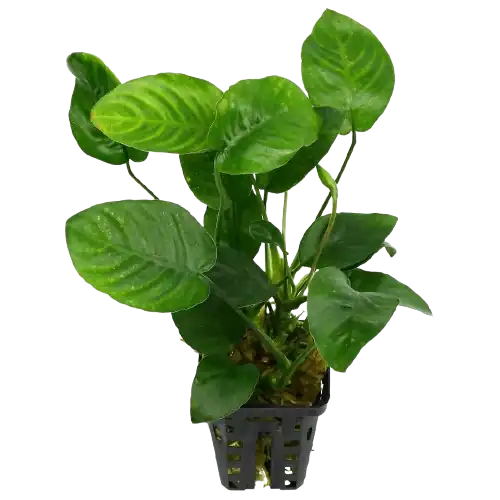
Anubias can be reproduced by putting seeds in the substrate or attaching them to driftwood or rock using fish line or thread. Its rhizomes should be left exposed and not buried in the substrate; otherwise, they will die out. While Anubias doesn’t require heavy fertilization, occasional use of liquid fertilizers can promote healthy growth.
One issue with Anubias is its slow growth, which makes it prone to algae overtaking its leaves. However, its low growth makes maintenance easy and stress-free for beginners. To maintain health, consider wiping algae off its leaves or adding algae eaters to the fish tank.
3. Java Fern (Microsorum Pteropus)
Java Fern is one of the most favored plants in the aquarium hobby, native to Malaysia, Thailand and Northeastern India. all known for betta’s origins. It’s a great beginner plant that requires deficient maintenance and will compensate for many newbie mistakes. Java Fern can be placed in the foreground or mid-ground and attached to decorations to create a visually appealing setup. Its aesthetic nature makes it an excellent choice for a fish hobby.
Java Fern comes in multiple varieties and physical forms each with different leaf sizes, textures and shapes, such as needle leaf, narrow leaf, windelov and lance leaf variants. Among these, the standard Java Fern with its broad green leaves, provides a natural environment similar to a betta’s native habitat.
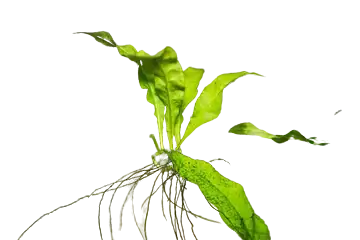
Java Fern thrives in low light and low energy, ranging from 40-125 PAR. High-intensity light can lead to algae growth on its leaves. The plan thrives in a wide range of temperatures from 62-82 F. It does not need CO2 to grow.
Java Fern follows asexual reproduction by producing small plantlets from the tips and edges of its mature leaves. These plantlets develop roots and can attach to surfaces or float to a new location if detached. Like Anubias, Java Fern’s rhizomes should not be buried in the substrate. Instead, keep the rhizomes exposed to prevent rotting.
Which one, Java Fern or Anubias?
Choosing between Java Fern and Anubias can be challenging because each has its own set of pros and cons. Anubias is highly hardy but quite sensitive to algae, whereas Java Fern is less susceptible to algae but very sensitive when moved around or to a new setup.
I prefer Anubias over Java Fern, even though it’s a bit delicate. Larger Anubias plants are more resilient to algae. Some people find Anubias tends to rot while Java Fern thrives; for others, the case may be the opposite. Java Fern also tends to develop spotted and dying leaves more frequently. Another difference is that Java Fern grows much faster than Anubias. However, Java Fern’s leaves can melt quickly if moved too often, making it more fragile and sensitive than Anubias.
4. Marimo Moss Balls (Aegagropila Linnaei)
Marimo Moss Balls, unlike typical aquarium plants, are spherical algae formations found in the lakes of Japan, Estonia and Iceland. Due to their low maintenance and aesthetic appearance, they make a superb addition to any aquarium. These algae balls act as a natural filter, consuming nitrates, nitrites and ammonia in the aquarium and helping oxygenate the tank.
These moss balls grow at a rate of 5mm/year and can be easily propagated by simply dividing them into smaller pieces. The summer season is perfect for moss balls to grow vigorously. My own Marimo shows potent growth during this season and exhibits a velvety and fine-textured surface. They have a long life span, even up to 100 years.
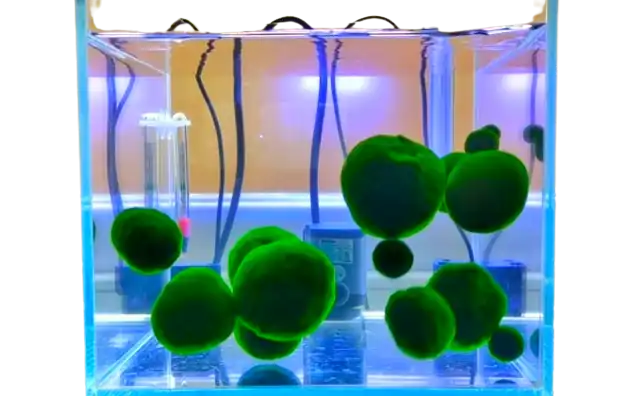
Betta fish enjoy playing with these moss balls, pushing and resting on them, which can help reduce their stress.
Marimo Moss Balls are an excellent option for those who find it challenging to care for plants because they are easy to maintain. They only require gentle rinsing and squeezing during water changes to remove debris and prevent dirt buildup. It’s also important to occasionally rotate the balls to maintain their round shape and ensure that all sides receive optimum light.
5. Wendt’s water trumpet (Cryptocoryne wendtii)
The Wendt’s water trumpet, known mainly by its scientific name Cryptocoryne wendtii or crypts for short, is a hardy aquarium plant that originates from Sri Lanka. Cryptocoryne is genus of aquatic aquatic plants from the family Araceae. This plant stands out from other aquarium plants due to its varying leaf colors, which range from green to brown, creating an appealing contrast in the tank.
It thrives in different water conditions and light intensities, ranging from 50 to 200 PAR, making it highly adaptable. The plant is also resilient to a wide range of pH levels, typically thriving in a pH range of 6.0 to 7.5, which aligns well with the requirements of betta fish.
Crypt is an excellent option for beginners as it requires little maintenance and grows slowly, reducing the need for frequent trimming.
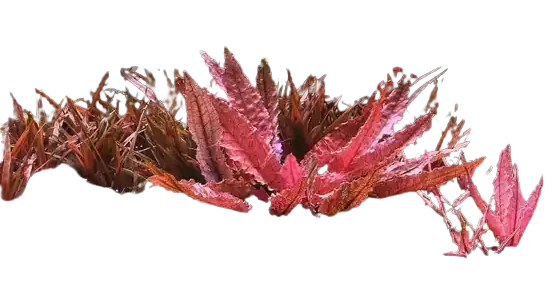
Like other rooted plants, it can be grown both submerged and immersed. Propagation is quite simple. Find the rhizome with leaves and roots grown on it and cut it with a knife or scissors. Plant this rhizome in the substrate, burrowing its roots. It will soon grow into a new plant.
Occasionally, the plant may undergo crypt melt, causing its leaves to dissolve. However, they typically regrow in different colors after acclimating to the tank conditions. If you have shrimps in the tank, they can help clean the melted leaves; otherwise, remove these leaves manually.
6. Water Sprite (Ceratopteris Thalictroides)
Water Sprite or Water Fern is found in tropical and subtropical regions worldwide. It is a fast-growing stem plant known for its delicate, lacy leaves and easy care, making it suitable for beginners. Although this plant can grow tall, regular pruning will keep it compact and low.
Like Marimo moss balls, they function excellently as natural filters, soaking up all the nutrients. Water Fern thrives in moderate to high light intensity. While it can survive in low light conditions, its growth rate will be somewhat slower.
As a fern species, it forms a dense herbarium of leaves that offers excellent hiding spots and resting areas for your betta.
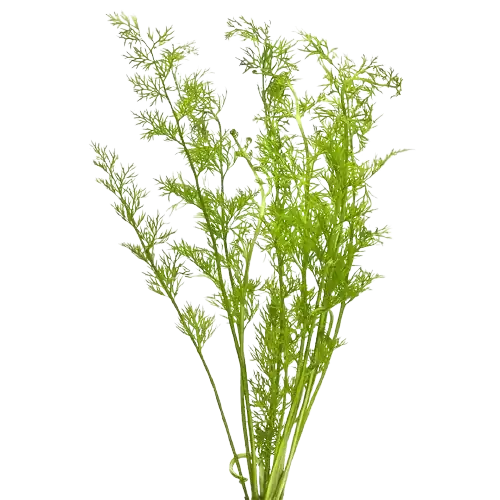
It propagates easily by producing small plantlets from its leaves. Cut these plantlets and replant them in the substrate or let them float. Both methods are effective, so it depends on the look you want for your tank.
7. Eelgrass, Tape Grass or Vallis (Vallisneria)
Vallisneria is a practical freshwater aquarium plant for backdrop placement in fish tanks. It is distributed in tropical regions of Africa, North America and South America. Vallisneria is a tall and thin-leaf plant that can grow up to several feet, creating a dense jungle-like appearance in aquariums. The tall, dense leaves of the plant provide excellent hiding spots and resting places for bettas, imitating their natural habitat.
Vallisneria is very adaptable and can sustain a wide range of tank conditions. It grows best under high light intensity but can also do well under moderate light conditions with a slightly slower growth rate. I’ve found that Vallisneria does well when planted in a substrate with iron-rich fertilizer. In my tank, I use plain gravel with occasional doses of liquid fertilizer, which has led to lush, healthy growth. It tolerates many water conditions, making it suitable for betta fish tanks. The plant flourishes in temperatures between 68-82°F (20-28°C) and prefers pH levels between 6.0 and 8.0, not accepting acidic water conditions.
It improves water quality by absorbing surplus nutrients, making it ideal for any aquarium setup.
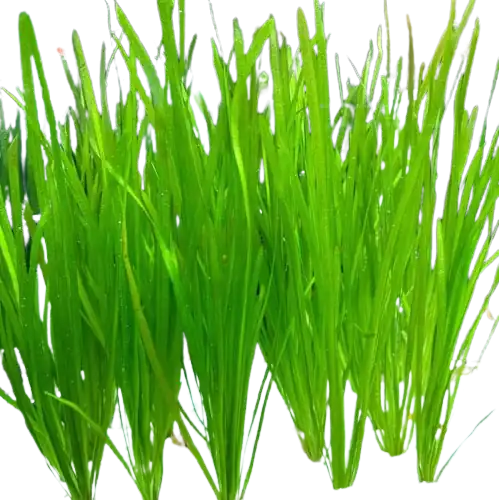
Vallisneria anchors deeply into the substrate, establishing a solid root system that propagates through runners, producing daughter plants. After developing their roots, these daughter plants can be cut away and transplanted.
One challenge I encountered while having Vallisneria in a betta tank was maintaining the right balance of water flow. While Vallis prefers a strong current, my betta doesn’t. By strategically placing the plants, I created a buffer that reduced the flow in certain areas, ensuring both the plant and my betta were happy.
8. Banana Plant (Nymphoides Aquatica)
The Banana plant is a unique aquatic plant named for its distinctive banana-shaped tubers, which are used either floating or attached to a hardscape. It is a unique addition to your aquarium, and taking care of it is a breeze. It adds delightful details to the tank with its long stems and round, broad leaves ranging from light to dark green. The leaves float on the surface of your tank, resembling water lilies, and can grow up to 4 inches in diameter.
The Banana Plant is well-suited to the conditions preferred by betta fish. It can grow without CO2, but it thrives in the presence of CO2. Banana plants are crucial for maintaining healthy water quality as they absorb nitrates and other waste products, effectively contributing to a cleaner aquatic environment.
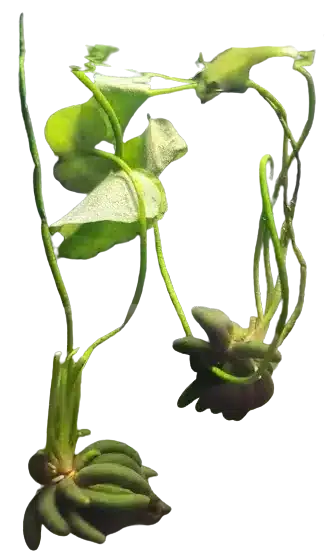
The Banana plant propagates through runners and new plants that grow from the base tubers. To propagate:
i. Separate the new growth from the mother plant and replant it in the substrate.
ii. Prune the leaves occasionally to avoid restricting light to other plants.
iii. Ensure the Banana plant’s tubers only settle into the substrate if you plan to keep it rooted there.
9. Java Moss (Taxiphyllum Barbieri)
One of the most straightforward masses to grow in an aquarium, it is native to Southeast Asia and is considered excellent for raising baby fish and tadpoles. Its deep green hue and thin fronds make it perfect for wrapping aquascaping rocks or driftwood. You can create various styles with the soft green fronds of the plant in the tank. Its tinkling nature makes it suitable for creating a moss carpet and serves well as a foreground plant.
Java Moss thrives under a wide range of water conditions and light intensities. These excellent masses can easily attach to driftwood or rocks without any substrate to thrive and grow. I keep the masses in my small betta aquarium because they do not grow tall or fast and do not need CO2 supplements.
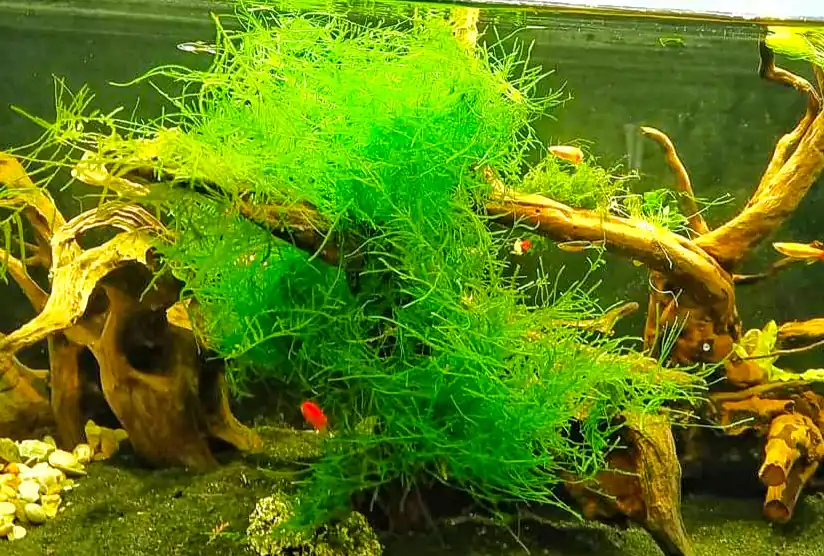
If it’s your first time growing Java Moss, you might face some challenges, just like I did. To deal with those issues, place the Java Moss in direct water flow. If you’re using low-intensity lighting, consider replacing it with a higher-quality one. You may also need Thrive fertilizer to support healthy growth. What I have noted, Java Moss can quickly take root and spread throughout the tank. Any small piece that breaks off can establish itself wherever it lands.
10. Anacharis (Egeria Densa)
Anacharis, also known as Elodea or Brazilian Waterweed, are native to South America, Brazil and Uruguay. It has long, lush green stems with numerous small and lance-shaped leaves. Depending upon your preferences, it can grow both anchored in the substrate or floating freely in the aquarium. I prefer to float it with essential lighting.
Anacharis acts as a nutrient sponge, absorbing excess nutrients to the point of potentially starving other plants. The reason I grew this plant in one of my betta aquariums is its anti-bacterial properties, allowing it to combat cyanobacteria. This plant controls algae in freshwater aquariums and contributes to oxygen production, creating an eco-friendly environment for your betta fish. Additionally, this plant can lower the pH of hard water by using bicarbonates, making the plant an excellent choice to keep if you have hard water.
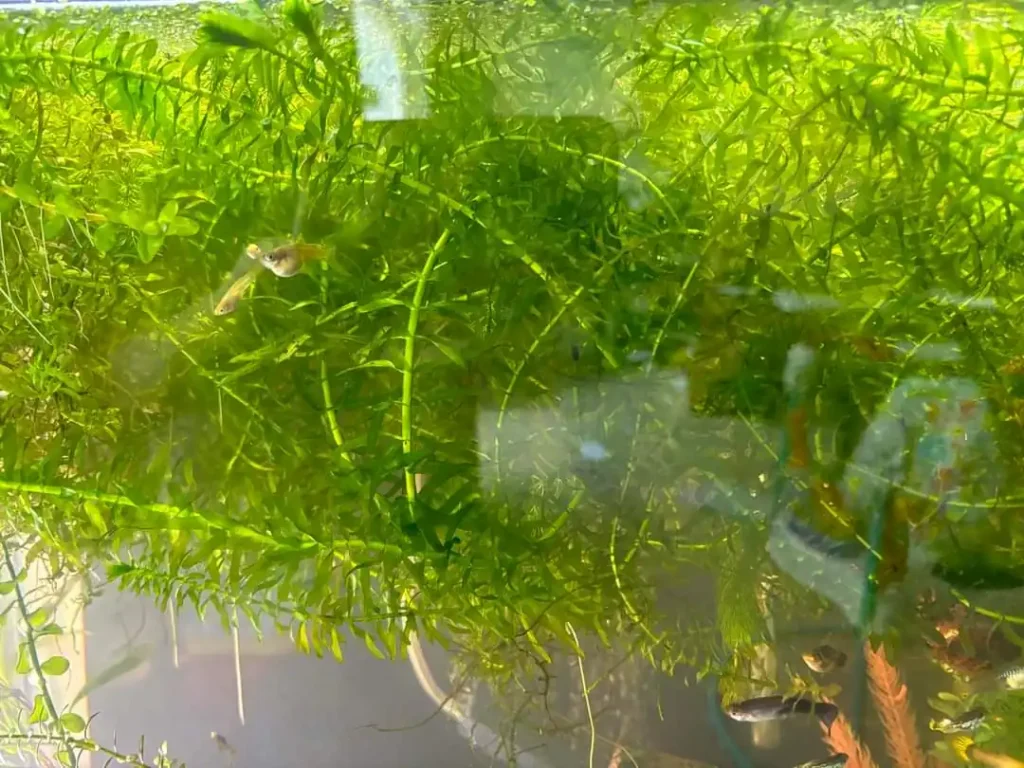
We highly recommend planting Anacharis in their newly set up tanks for beginners because it’s an undemanding plant that can help resolve various aquarium health issues, some of which you may not even be aware of.
For a complete guide on keeping your betta healthy and happy, check out our detailed article on betta fish care.
Floating Plants in Betta Tank
Other plants you can try in your betta tank are the floating ones. Floating plants are an easy way to make a betta tank feel cozy. They create a leafy cover on top, which gives your betta shady spots to hang out and helps them feel safe. Plants like frogbit, water lettuce, and Salvinia grow fast and even soak up extra nutrients from the water, keeping things balanced.
I’ve seen my bettas become more playful and relaxed when floating plants are around, since it feels closer to what they’d have in the wild. Just be ready to trim them back now and then so they don’t take over and block all the light.
Fake Plants for Betta Fish
While many hobbyists love live plants, not everyone finds them easy to maintain. This is where fake plants especially silk ones come in. Fake plants don’t provide the same benefits as live ones, such as producing oxygen or consuming tank waste, but they can still be a great alternative if you’re a beginner or struggle with keeping live plants alive. Live plants require extra work like trimming, regular lighting, and fertilizers, which isn’t for everyone.
Despite some drawbacks, fake plants still offer plenty of benefits. They add beauty to the tank, mimic a natural habitat, and create hiding spots for your betta. The key is choosing the right kind of fake plant.
When it comes to fake plants, there are two main options: plastic and silk. I don’t recommend choosing plastic plants over silk ones, since plastic can be risky. Many have sharp edges that can tear betta fins, and cheaper versions may even leach chemicals into the tank. While I’ve come across some soft plastic plants that are safe, you really need to test them before trusting them in your betta’s home. For peace of mind, I always stick with silk.
Silk plants are soft, safe, and look great. Once in the water, they appear much more natural than plastic and even sway slightly like real plants. They’re also very easy to clean, just rinse them off and place them back in the tank. For me, silk plants are the perfect choice to keep a betta tank safe, attractive, and stress-free.
Mixing Live Plants and Fake Plants
I have also tried mixing live and artificial plants in my 10-gallon betta tank. This setup proves to be more efficient because live plants make the tank look more natural and help improve water quality by aiding filtration. At the same time, artificial plants are a stress-free way to fill in empty spots and add color without the extra care.
I usually place real plants in areas where they can grow freely and benefit the tank, while using fake ones in the corners. The only thing you need to ensure is that fake plants don’t block access to the live ones, since they need space for pruning and cleaning to stay healthy.
Our Advice on Betta Fish Plants
Plants, like people, need time to adjust to new homes.
Your patience, consistency and small acts of care will make the biggest difference. Stick with it, and soon you’ll enjoy the vibrant, thriving aquarium you imagined, and you’ll have earned every leaf of it.

